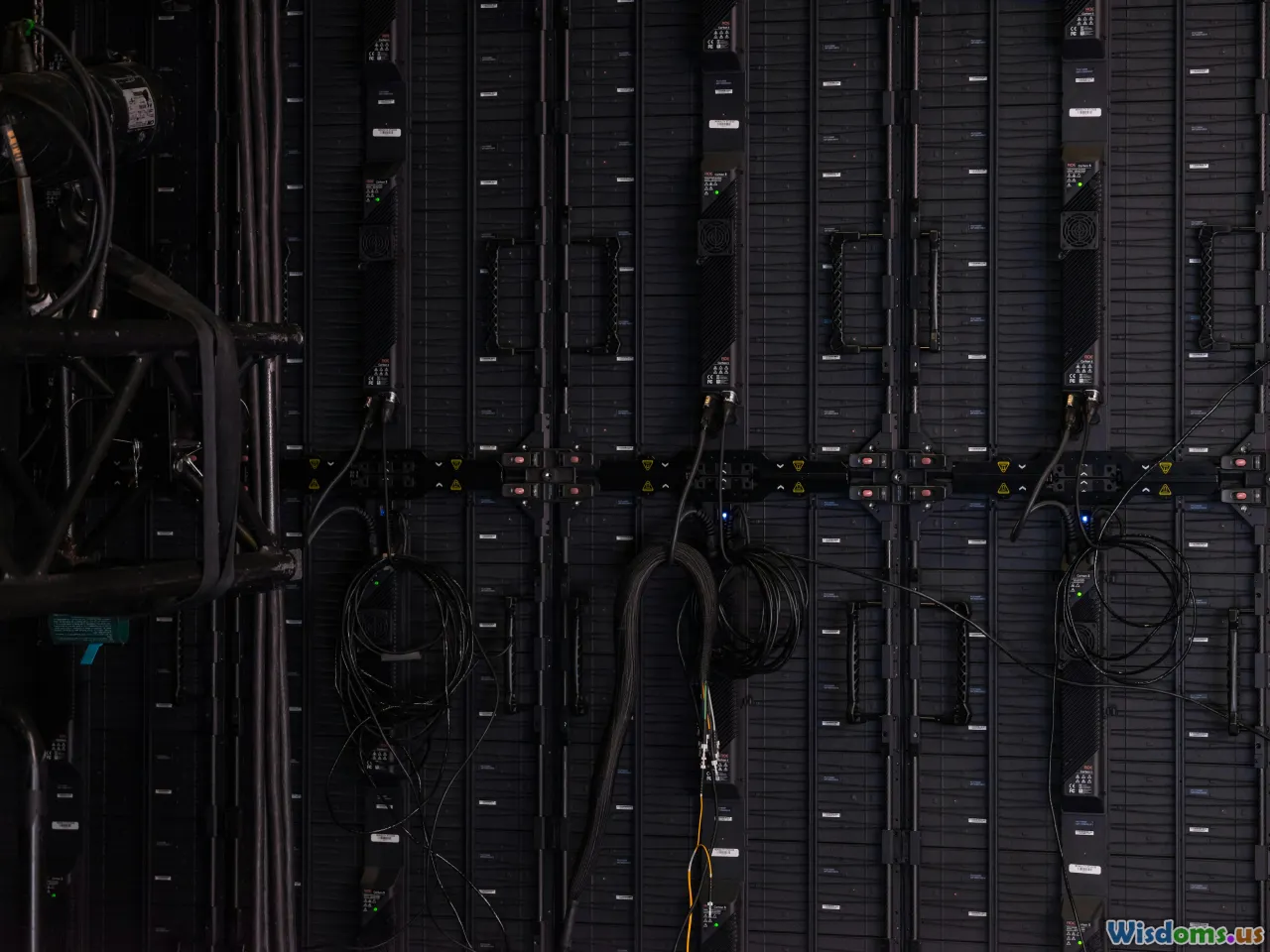
A Day in the Life Using Supervised Learning at Scale
15 min read Explore the practical workflow and challenges of implementing supervised learning models at scale in real-world environments. (0 Reviews)
A Day in the Life Using Supervised Learning at Scale
As the morning sunlight filters through the blinds, a data scientist sips their coffee and prepares to wrangle several terabytes of data tagged for a retail algorithm. Running a supervised learning pipeline is no longer a small, experimental project—it’s the digital heartbeat of thousands of industry leaders. From real-time e-commerce recommendations to intricate fraud detection systems, scaled supervised learning solutions have woven themselves into the fabric of contemporary business. But what does a single day look like when you’re using supervised learning at scale? Let’s journey through the process, uncover the intricate details, and explore actionable insights from the cutting edge.
Building the Data Backbone

No scalable supervised learning solution exists without an impeccable data pipeline. Early in the day, the analytics team interfaces with data engineers, monitoring the transfer of terabytes from distributed e-commerce logs, sensor networks, or transaction histories into data warehouses.
Concrete Example: A major online retailer collects interactions from millions of users daily. These raw log files are stored in Amazon S3, Google Cloud Storage, or Azure Data Lake. The ETL (Extract, Transform, Load) process cleans and standardizes fields, identifies missing values, and structures the data for model consumption, using tools like Apache Airflow and Spark.
Key Insights:
- Data Quality at Scale: Automated validation scripts catch anomalies (e.g., thousands of missing product IDs from a new batch) in real time, preventing bad data from derailing the training process.
- Metadata is Key: Automated tags record the source system, collection timestamp, and change events. This transparency avoids the classic “garbage in, garbage out” syndrome.
- Version Control: Datasets are versioned, often using solutions like DVC (Data Version Control), ensuring reproducibility.
Feature Engineering on Gigantic Datasets

Next comes the critical task of feature engineering—transforming raw data into variables that best predict a target label. At scale, feature engineering isn't just a creative act, it's a logistical puzzle.
How Teams Tackle It:
- Parallel Computation: Technologies like Apache Spark and Dask allow feature transformations (think aggregated user actions, temporal spans, or derived ratios) to run across tens or hundreds of machines simultaneously.
- Reusable Feature Stores: Instead of repeatedly computing common features (such as customer lifetime value), organizations use feature stores like Feast or Tecton to centralize, version, and serve them at both training and inference.
Actionable Tip: Design feature pipelines with modularity. For example, when a financial services company needed to introduce a new fraud detection algorithm, modular features like "transaction frequency in last 24 hours" and "average ticket size per merchant" could quickly be swapped, tweaked, or rolled back.
Managing Massive Labels: Annotation and Quality Assurance

Supervised learning hinges on labeled data, and at scale, creating and managing high-quality labels is both a logistical feat and a source of competitive differentiation.
Concrete Example: A global logistics firm seeks to predict parcel delivery failures. Tens of millions of packages annually are labeled as either "on-time" or "failed" based on delivery scans and customer feedback. Implementing an annotation QA system detects ambiguous outcomes—for instance, whether a package marked “held at facility” truly failed.
Best Practices:
- Human-in-the-Loop Systems: Combining automated label suggestions with expert validation dramatically accelerates annotation throughput without sacrificing quality.
- Continuous Evaluation: QA teams regularly audit labels, using blind reannotation or consensus mechanisms, which is essential for datasets that can drift or change over time.
Pro Insight: Companies now adopt iterative labeling—where uncertain, edge-case data points are consistently re-reviewed—which maintains high-fidelity ground truth and reveals rare but business-critical occurrences.
Training Models Across Massive Infrastructures

With robust datasets and features locked in, training the actual supervised models becomes an act in distributed computing. A single day could see dozens of model runs on datasets that span from terabytes to petabytes and millions to billions of examples.
Technology Stack Example:
- Cluster Scheduling: Organizations employ Kubernetes, Kubeflow, or Amazon SageMaker to schedule and manage training jobs over GPU or TPU clusters.
- Model Frameworks: TensorFlow, PyTorch, and XGBoost remain popular due to their distributed training capabilities. Tools like Horovod further simplify multi-worker training.
Challenges and Solutions:
- Efficient Checkpointing: Automated checkpointing ensures that long training jobs aren’t lost when hardware or network fails.
- Hyperparameter Search at Scale: Companies execute parallel hyperparameter tuning (via Ray Tune or Optuna), running hundreds of experiments to identify optimal settings quickly.
Case in Point: A fintech company uses LightGBM on a 50-node cluster, reducing training time for its credit-risk model from days to hours. Early stopping hooks and online learning methods prevent costly overfitting and boost deployment velocity.
Ensuring Model Integrity and Fairness

Model evaluation at scale looks far beyond classic metrics like accuracy or mean squared error. Increasingly, businesses must guard against hidden biases, ensure explainability, and embed compliance into their workflows.
Analysis:
- Bias Auditing Tools: AI fairness solutions (IBM AI Fairness 360, Google’s What-If Tool) now scan for disparate impact along gender, race, geography, or other variables.
- Automated Reports: At scale, dashboards continuously monitor model drift, prediction distributions, and changes in input data characteristics. This proactive stance helps prevent incidents like a shipping model over-penalizing certain zip codes.
- Explainability in Action: With tools like SHAP, LIME, or integrated Grad-CAM visualizations overlays, teams can trace the reasoning behind a model’s prediction—crucial for regulated industries or user trust.
Tip: Operationalize fairness checks: Companies automate periodic, slice-based performance tests to catch degrading accuracy across minority groups, time segments, or locations.
Real-Time Deployment and Scalable Inference

Once they are trained and validated, supervised learning models must rapidly serve predictions to production systems—sometimes millions per second.
Deployment Workflows:
- Containerization: Docker images of models, bundled with runtime dependencies, are deployed via Kubernetes or cloud-native services. This guarantees consistency from dev to prod.
- Model Serving Frameworks: Tools like TensorFlow Serving, TorchServe, and NVIDIA Triton streamline batched or real-time model inference, holding up under surges in traffic thanks to autoscaling cloud infrastructure.
- A/B Testing and Canary Releases: New models launch side-by-side with previous versions, with real users only "seeing" the new output incrementally. This protects CX and ensures business continuity if rare edge-case failures occur.
Example: A streaming media company predicts minuteby-minute user churn, serving billions of requests per day using serverless endpoints across cloud regions to minimize latency globally.
Actionable Advice: Use queue-based pre-processing and model caching for spike-prone workloads—minimizing cold start delays and maximizing throughput.
Monitoring, Retraining, and the Feedback Loop

The supervised learning workflow never really ends—it cycles. Today, advanced monitoring drives swift retraining, adapting to ever-changing data from the real world.
How-to Ensure Model Longevity:
- Continuous Data Logging: Every user interaction is logged—models rarely act in a vacuum. These live samples feed periodic model health checks; automated triggers kick off retraining pipelines upon detecting data drift.
- Performance Alerting: Dashboards issue alerts if accuracy, recall, or fairness measures decline, flagging issues like concept drift that can silently erode results.
- User Feedback Integration: For certain applications—think content moderation or personal finance—manual overrides and user-reported corrections are pipelined as training signals, closing the loop and making models smarter with each day’s interactions.
Industry Snapshot: An e-commerce marketplace detected significant model drift during a 2023 holiday surge—an influx of new product lines briefly tanked recommendation relevance. Pipeline automation allowed rapid retraining on fresh interactions, restoring personalized results within hours.
Navigating Challenges Unique to Scale

Supervised learning at scale isn’t just "bigger"; it’s fundamentally different than small-scope ML. Special bottlenecks and pain points surface, demanding robust, innovative solutions.
Key Challenges:
- Resource Bottlenecks: Costly GPU clusters can be oversubscribed; savvy teams schedule jobs during cloud off-hours or leverage preemptible instances to save money.
- Data Privacy and Security: Strict controls and data anonymization maintain privacy compliance. For example, a healthcare AI must HIPAA-proof its training pipeline config.
- Collaboration Over Distance: Multi-team, multinational groups coordinate using experiment management platforms (Weights & Biases, MLflow) and clear documentation standards to avoid disastrous confusion over code or data versions.
- Debugging Distributed Jobs: Failures can be opaque on sprawling clusters. Trick: Engineers inject rich error logs and simulation runs on mini-synthetic datasets before scaling up.
Comparison: Unlike boutique projects, the scaled teams invest heavily in observability tools, disaster recovery plans, and cross-discipline communication—essentials to stay productive when just one small hiccup can have sweeping business impacts.
Actionable Strategies for Aspiring Scale Champions

Whether you’re about to move beyond the laptop or recently inherited a scaled pipeline, certain strategies can set up your day (and your future projects) for success:
- Invest in Automation: Tedious manual steps are enemies at scale. Automate everything that recurs, from standard feature engineering to bake-off experiments and deployment triggers.
- Keep Teams Educated: The best solutions are shared ones. Guilds and lunch-and-learns across data science, engineering, and QA teams spread platform improvements quickly.
- Design for Explainability Early: Pick algorithms and frameworks that support visibility into decisions, even if it means additional overhead. Retrospective patching is expensive.
- Promote Agile Experimentation: Structured pipelines and containerization let you run rapid, reproducible experiments. Your day flows smoother when you trust your infrastructure.
- Document Everything: At scale, designs, assumptions, and learnings are quickly forgotten. Organized architecture diagrams, changelogs, and experiment scripts are lifesavers six months later.
Pro Tip: Even at global scale, small, carefully run proofs of concept can pre-validate architecture shifts (such as moving from Spark to Ray or Kubernetes), de-risking expensive transitions.
A day in the life using supervised learning at scale is part symphony and part high-wire act—a testament to the interplay of robust architecture, relentless iteration, and genuine collaboration. As industries embrace ever-growing datasets and ever-finer decisions, those who master the art of scaling supervised learning pipelines will turn this complexity into a distinctive competitive edge. Every day, new data flows in, algorithms evolve, and teams learn—the perfect cadence for driving meaningful change in a data-powered world.
Rate the Post
User Reviews
Popular Posts


















